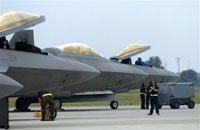USA's next president to be penny-pinching commander-in-chief
The next U.S. president, John McCain or Barack Obama, is expected to be a penny-pinching commander in chief when it comes to buying new military weapons. And that's bad news for the Air Force's push to buy scores more F-22 Raptors, a supersonic jet fighter built to dominate enemy airspace.

At $191 million apiece, extra Raptors will be a hard fit in a defense budget likely to begin shrinking after eight years of steady growth under U.S. President George W. Bush. The jet's expense may be its biggest vulnerability.
The Raptor hasn't been used to fight Islamic terrorism, another factor working against it. In the aircraft's corner is Congress, which may find the cash if the White House won't.
At Langley, home to the Air Combat Command and 40 ash-gray F-22s, ending production of the Raptor is a troubling prospect. Air Force officials point to Russia's attack in August on neighboring Georgia, a U.S. ally, as proof the nation must be prepared to do more than hunt down terror groups.
The conflicts in Iraq and Afghanistan, mostly battles fought on the ground, aren't matters of national survival, they say. Wars against heavyweights like Russia and China, or a nuclear-armed Iran, would be.
"We seem to have talked ourselves, in the West, into the idea that the Cold War is over, (that) historical military competition is over - that we may be faced with a counter-terror threat emanating from the Middle East, and that somehow the rest of the world is going to respect this unilateral respite that we've declared," Brig. Gen. James Poss, intelligence director at Air Combat Command, told The Associated Press in an interview.
The Bush administration says the 183 Raptors the Air Force has already bought are enough to deal with future threats.
Defense Secretary Robert Gates on Monday said there needs to be a better balance between expensive, high-tech weapons and more basic gear that's critical for fighting counterinsurgencies. He didn't mention the F-22 during a speech at the National Defense University in Washington. But Gates did caution against "rearming for another Cold War."
Overall, close to $65 billion has been spent on research, development and production of the aircraft.
In addition to the Raptors, the Air Force is buying more than 1,700 new F-35 Lightning jets. But the first batch of those planes won't be ready for action for a few more years. Each F-35 costs $104 million.
The Air Force says the performance of the F-22s and single-engine F-35s aren't comparable, though. The F-22 is more agile, can evade radar, and has twin engines that allow it to fly at faster-than-sound speeds without using gas-guzzling afterburners. The Air Force says both jets are needed. The F-35s will be used to hit targets on the ground, while the F-22s control the sky.
Even before the $700 billion bailout plan for the U.S. financial system emerged as a staggering expense for taxpayers, pressure was growing to cut defense spending. The main culprits: a sluggish economy, a $500 billion federal deficit and the expanding costs of Social Security, Medicare and other mandatory programs.
For 2008, the Defense Department's budget is $657 billion, which includes the cost of the wars in Iraq and Afghanistan.
During the presidential debate in Mississippi, McCain called defense spending "very important and vital." But he also said the cost of weapons systems "are completely out of control." McCain has been among the Air Force's sharpest critics - despite serving as a Vietnam-era Navy fighter pilot. In 2006, McCain lost a contentious battle with other lawmakers to deny a multiyear contract for 60 of the F-22s.
Also in the debate, Obama said his top budget priorities are energy independence, health care, education and rebuilding America's network of highways and bridges. He didn't mention buying more jet fighters.
During his Senate confirmation hearing this summer, the new Air Force chief of staff, Gen. Norton Schwartz, backed away from the Air Force's long-held position that it must have 381 F-22s. He's still studying how many are needed but said 183 of the jets aren't enough.
The wild card will be Capitol Hill, where support for the F-22 is strong. Like any big military project, building more Raptors means jobs. Most of the aircraft are being built by Lockheed Martin in Georgia and Texas. Boeing manufactures the wings and other parts in Seattle. The engines are supplied by Pratt & Whitney in Middletown, Connecticut.
Congress added $523 million to the 2009 budget for advance procurement of more jets in hopes the next administration will keep the program alive.
"Anything can happen," said Christopher Bolkcom, a national defense specialist with the Congressional Research Service in Washington. "The pressures to continue this are just going to be crushing."
Subscribe to Pravda.Ru Telegram channel, Facebook, RSS!




